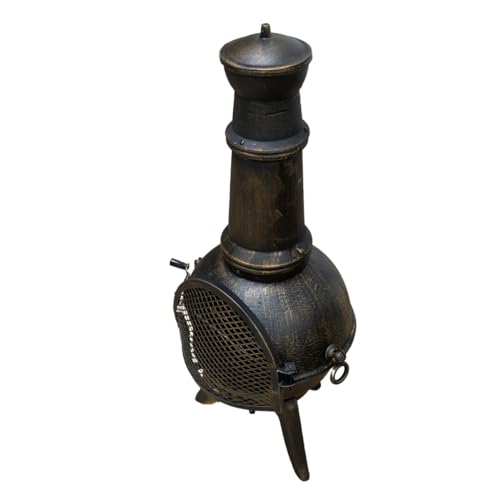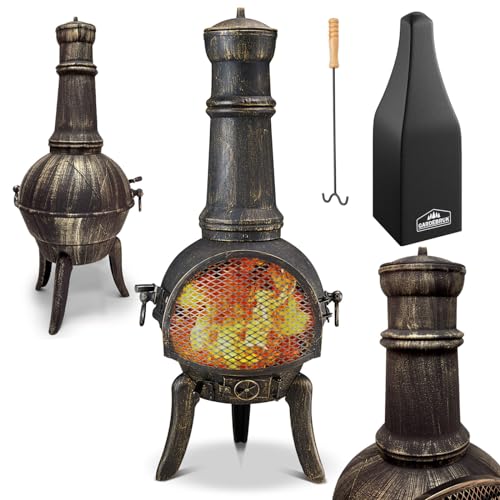Small Chiminea Tools To Ease Your Everyday Lifethe Only Small Chiminea…
페이지 정보

본문
 A Small Chiminea Provides Warmth Without the Mess
A Small Chiminea Provides Warmth Without the MessWith this small chiminea, you get all the warmth of a wood-burning fireplace without the mess. Simply place lightly scrunched newspaper in the sand, or put a log grate inside, and add kindling and logs before lighting.
This sleek black chiminea features an oxidized look for casual flair. The 360-degree grate maximizes your burning flames and the tall chimney funnels smoke upward and away from you.
Types
A small chiminea is used to provide warmth to the patio or outdoor seating area. They also make a great alternative to a barbecue grill for cooking outdoors. These grills are available in a variety of materials, from clay made of terra cotta, to cast iron and steel. They can be made in a more traditional or modern chiminea style.
Some models have chimneys that direct smoke away from the seating area. This may be useful for those who reside in an area where there are rules regarding the amount of smoke outdoor fireplaces and other sources of heat can emit. Certain models come with an ash screen and a spark screen within the fireplace. It is possible to select an ash catcher with a larger capacity for fire or one that is able to hold a lot wood, depending on the dimensions of the area.
The type of material your chiminea is constructed of is crucial as it can affect its performance and the way it appears in your outdoor space. Terra cotta models offer an elegant look, however it is prone to being damaged from the elements. A chiminea made of metal is more durable, however it might require a protective coating to prevent rust. A hybrid chiminea is made from a mixture of cast iron and stainless steel. It may offer the best characteristics of both.
The size of your chiminea may affect the amount of heat that is generated. A larger chiminea sale weighs more and is more expensive but can produce more heat.
Chimineas typically have a beautiful surface which gives them a appeal. Some are decorated with ornaments or carved designs, while others have simple lines and a plain finish. Some have a lid which helps protect the flames and keep pets and children from getting too close. Certain models come with doors that make it easier to add fuel or to remove the ashes. You can find chimineas with built-in barbecues, which allows you cook food over an open flame.
Safety
If you're thinking about purchasing a small chiminea there are a few crucial safety measures to keep in mind. Chimineas are not inherently unsafe however they can become hot and pose a danger to pets and children if you're not careful. By taking a few precautions, you'll ensure that you're able enjoy your chiminea in peace for many years to come.
It is crucial to realize that the fireplace or stove made of wood is not an Chiminea. In contrast to these types of devices, they don't have dampers that control burning and are easily damaged when handled improperly.
Always put a fire-proof cover for your chiminea to stop rain from getting into the chiminea and causing it to crack. This will also help to reduce smoke nuisance. You may also want to consider purchasing a freestanding, fireproof frame that can stand above the smoke stack and protect it from the elements.
Chimineas can generate lots of sparks when they burn therefore it is best to keep them away from explosive materials like fences, clothes lines and plants. It's also a good idea to clean the area around your chiminea before lighting it, and to ensure that it has at minimum six feet of distance from anything combustible.
Another safety measure is to avoid using gasoline, lighter fluid, or any other accelerant in your chiminea. These liquids could cause an explosive explosion inside the chimney, and pose an hazard to fire. It is also not recommended to use water to light the flames in a chiminea because it can cause the clay to crack, or even break.
You should only make use of wood for your chiminea as it will produce less smoke and heat than other fuels. When you light your chiminea, begin with small pieces of kindling then add larger logs to the flames. If you are having difficulty lighting the kindling you can try putting newspaper into a ball and placing it on the grate. This will create a powerful draft which will ignite the paper and kindling.
Do not burn a chiminea in the house because it releases harmful carbon monoxide fumes which can cause death to people and animals alike. Additionally, it's an ablaze hazard and could cause serious damage to your home.
Maintenance
A chiminea terracotta is a beautiful addition to any outdoor space, and it provides warmth and ambience when it is used regularly. Proper maintenance enhances its appearance and helps prevent injuries and dangers to safety and ensures that it will be enjoyed for many years to come. Regular cleaning and inspections of both the exterior and interior should be part of the routine care, as well as proper storage in off-season weather conditions.
Chimineas should be put in a place which is clear of overhanging structures and branches and away from any combustible material such as concrete and pavers. It is also hazardous to place a chiminea beneath the roof, or on any other structure. Sparks can fly from the chimney and ignite whatever is above. The area should be clear and large enough to hold the entire chiminea, including flue, with a few feet of clearance on all sides to ensure safe use.
Chiminies can be cleaned using water and a mild detergent using soft brushes to ensure that the surface is not damaged by the clay. After washing the chiminea, it should be thoroughly rinsed and then allowed to dry completely. It is important to remove all ash from the chimney and chiminea bowl prior to cleaning. Wearing gloves while cleaning is crucial to avoid contact with hot soot or ash. During the cleaning process, be sure to inspect the interior and exterior of the vehicle for any cracks or chips which may need to be repaired.
Most biggest chiminea retailers sell a clay repair kit that can be used to fix cracks. These kits include all the necessary sealants and adhesives to fix minor cracks and fractures. If a fracture is left untreated and it gets worse, it can turn into an issue that threatens the safety and integrity of the chiminea.
To keep the chiminea in good shape, it should be fueled by natural wood products that are dried and seasoned. Burning materials such as painted or treated plastics, wood, and garbage can release toxic fumes that are harmful to a chiminea. A properly-used fuel and regular maintenance can help prevent cracking or damage caused by excessive heat. It is also important to control the size of fires within the chiminea, and avoid massive, roaring fires that could cause thermal stress and shock to the clay.
Cleaning
A chiminea that is properly maintained will provide many warm and social evenings. But, like most outdoor furnishings and equipment, it requires regular cleaning to ensure optimum performance. It is essential to ensure safety, with gloves and goggles necessary to shield your skin from dust and debris while cleaning. It is also essential to make sure that the chiminea remains cool before starting the cleaning process. This will not only safeguard your skin but also prevent the inhalation of harmful particles that could be hot after previous fires.
Get rid of any large clumps that have accumulated in the chiminea before you begin cleaning. Dispose of them in an appropriate manner. Using a wire brush, gently brush off any loose rust, always remembering to wear your protective equipment. A light sanding can be beneficial, too, as this can help remove any rust particles that are missed by the wire brush and smooths the surface of the chiminea ready to be painted with a high-heat paint suitable for grills or fireplaces.
Most home improvement stores sell clay repair kits. This inspection should be done prior to using the chiminea because it will help to strengthen the clay and make it ready for regular heating. This is a good method to examine the chiminea's condition for cracks and other damage that may not be obvious when it's not in use.
It is important to remember that you should use a chiminea outside on a non-flammable base such as a concrete or sand slab or hearth pad. This is particularly important for families with pets or children who could be enticed by the burning embers, or located close to flammable materials such as wooden fences and plants, garden lighting and furniture. When not in use, you should also put an lid over the chiminea to help reduce the chance of an explosion spreading.

- 이전글9 Signs That You're The Oven Expert 24.12.09
- 다음글The Advanced Guide To Reprogramming Car Key 24.12.09
댓글목록
등록된 댓글이 없습니다.